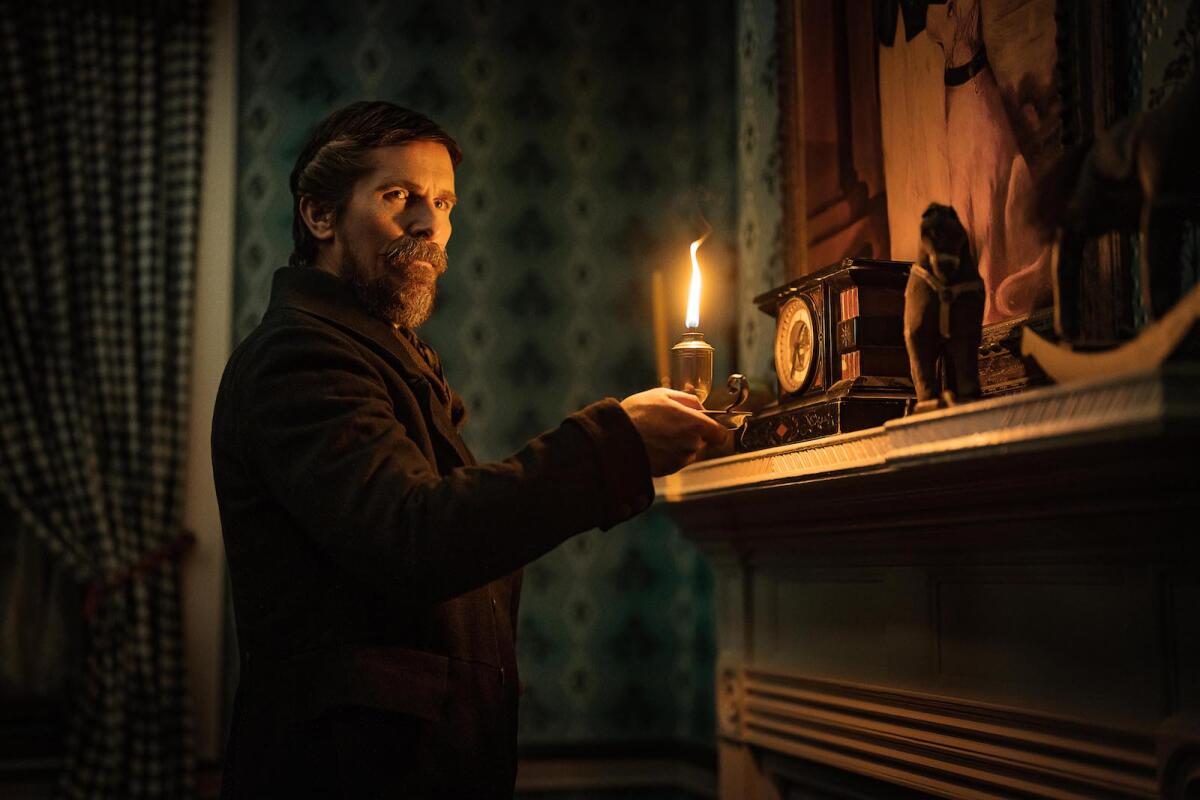Review: A striking look elevates Christian Bale murder-mystery ‘The Pale Blue Eye’

- Share via
What “The Pale Blue Eye,” a gothic mystery-thriller adapted by director Scott Cooper from Louis Bayard’s 2006 novel, may lack in fully propulsive storytelling and consistent narrative focus is more than made up for by its handsome physical production and gorgeous camerawork. For its visual appeal alone it’s worth a theatrical visit ahead of its Netflix premiere next month.
Cooper is a vivid, intense, deliberate filmmaker, as evidenced by such past films as “Crazy Heart,” “Out of the Furnace” and “Hostiles.” He doesn’t make it easy on viewers as he works to envelop them in dark, often harsh environments and a gallery of haunted, deeply lived-in characters. From his arguably best picture, the 2015 gangster drama “Black Mass” (sorry, “Crazy Heart” fans), to perhaps his least successful, the grim 2021 genre pic “Antlers,” Cooper is an actor’s director whose performers’ efforts tend to eclipse the material at hand. Cooper’s prior experience as an actor (“Gods and Generals,” “Get Low,”) has served him and his casts especially well.
For your safety
The Times is committed to reviewing theatrical film releases during the COVID-19 pandemic. Because moviegoing carries risks during this time, we remind readers to follow health and safety guidelines as outlined by the CDC and local health officials.
Such is the case once again in the 1830-set “The Pale Blue Eye,” which reunites Cooper for the third time, after “Furnace” and “Hostiles,” with the fearlessly talented Christian Bale. An acting chameleon, who most recently made a meal of his Pacino-inflected, one-eyed surgeon in David O. Russell’s period curio “Amsterdam,” Bale stars as Augustus Landor, a widowed, retired New York City constable brought on to investigate the apparent suicide of a West Point cadet named Fry (Steven Maier).
Given that it’s still the early years of the now-famed military academy, the powers that be — Col. Sylvanus Thayer (Timothy Spall), the school’s first superintendent, and his second-in-command, Capt. Ethan Hitchcock (Simon McBurney) — want Augustus to solve the case quickly and discreetly to preserve West Point’s burgeoning reputation.
But speed is off the table when Augustus learns that the victim’s heart was proficiently removed from his chest and that the “suicide” was a homicide. The local medical examiner, Dr. Daniel Marquis (Toby Jones), seems a bit elusive (or is it sinister?) when dealing with Augustus on the case. But then again, so do others around West Point, including such cadets as Dr. Marquis’ charismatic and ambitious son, Artemus (Harry Lawtey), and volatile bully Randy Ballinger (Fred Hechinger).
There is one cadet, though, who seems inclined to help Augustus, and he’s a bit different, daresay more eccentric, than his classmates. Oh, and his name is Edgar Allan Poe — yes, that one. (Poe did, in fact, attend West Point for seven months around that time, although no known killings took place.) Something of an outcast and a rebel compared to his more dutiful fellow cadets, aspiring poet Poe (Harry Melling of “The Queen’s Gambit”) is drawn to the darker facets of the crime and offers a window into the cadet world for Augustus.
Poe’s florid speech and arch manner, along with a witty and perceptive persona, help foretell the iconic writer he would become. It serves as a kind of What-if? Poe origin story and one of the film’s more compelling aspects. (It’s no coincidence that one of Poe’s most famous short stories is called “The Tell-Tale Heart” and features a victim with “a pale blue eye.”)
But a second cadet killing with a less, uh, “efficient” heart removal, sends Augustus and Poe in new directions that introduce us more deeply to Dr. Marquis’ offbeat family, which includes his erratic wife, Julia (an over-the-top Gillian Anderson), and lovely, musical daughter, Lea (Lucy Boynton), who’s plagued by epileptic seizures. Suffice to say, things get pretty strange.
As many intriguing parts as there are to the eerie tale, they’re blunted by the film’s overly measured pace and a split in narrative point of view: Is this ultimately Augustus’ story or Poe’s, especially as Poe falls for Lea and an unlikely — and rather quick — alliance is formed.
Augustus’ alcoholism, his wife’s death, a missing daughter and his warm relationship with a town barmaid (Charlotte Gainsbourg) also factor in to varying degrees.
Still, a late-breaking, didn’t-see-it-coming twist redeems some of the script’s less effective elements.
Robert Duvall, now 91, shows up in a small but welcome role as a phrenologist (one who studies skulls) and occult expert who offers Augustus and Poe possible insight into the bizarre killings. Kudos to the picture’s hair and makeup designers who did ace work on the venerable actor (the desired look was reportedly that of Russian author Leo Tolstoy) — and on the rest of the cast as well. Excellent costume and production design too.
But the cinematography by frequent Cooper collaborator Masanobu Takayanagi is the real secret weapon here as it captures, in picture-postcard perfection, upstate New York’s wintry, ice-blue starkness (western Pennsylvania subbed for the Hudson Valley), often set against the warm blue of the cadets’ uniforms; frames appear almost monochrome with painterly blotches of color. The burnished, candlelit glow of an array of interior locations is also strikingly shot. And that “ice house” scene — wow.
'The Pale Blue Eye'
Rated: R, for some violent content and bloody images
Running time: 2 hours, 8 minutes
Playing: Starts Dec. 23, Landmark Westwood; Los Feliz 3; Bay Theater, Pacific Palisades; available Jan. 6 on Netflix
More to Read
Only good movies
Get the Indie Focus newsletter, Mark Olsen's weekly guide to the world of cinema.
You may occasionally receive promotional content from the Los Angeles Times.










